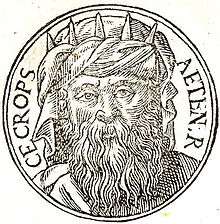Cecrops I


Cecrops /ˈsiːˌkrɒps/ (Ancient Greek: Κέκροψ, Kékrops; gen.: Κέκροπος) was a mythical king of Athens who, according to Eusebius reigned for fifty years. The name is not of Greek origin according to Strabo,[1] or it might mean 'face with a tail': it is said that, born from the earth itself, he had his top half shaped like a man and the bottom half in serpent or fish-tail form. He was the founder and the first king of Athens itself, though preceded in the region by the earth-born king Actaeus of Attica. Cecrops was a culture hero, teaching the Athenians marriage, reading and writing, and ceremonial burial.
Mythology
He is said to have been the first who deified Zeus, and ordained sacrifices to be offered to him as the supreme Deity. He is likewise affirmed to have been the first who set up altars and statues of the gods, offered sacrifices, and instituted marriage among the Athenians, who, before his time, it seems, lived promiscuously. Pausanias tells us that he forbade the sacrificing of any living creatures to the gods, as well as any sort of other offering, only allowing cakes formed into the shape of an ox with horns, called by the Athenians Pelanous, which signifies an ox. He is likewise said to have taught his subjects the art of navigation; and, for the better administration of justice and intercourse among them, to have divided them into the four tribes called Cecropis, Autochthon, Actea, and Paralia. Some likewise make him the founder of the areopagus.
During his reign, Athena became the patron goddess of the city of Athens in a competition with Poseidon. The two raced ferociously towards the Acropolis. It was a very close race, but Athena, as judged by Cecrops, won. As evidence of her victory she planted an olive tree. Poseidon arrived moments later, struck the acropolis with his trident and thereby created a salt sea. But Athena had already won, and the city was hers.
The Acropolis was also known as the Cecropia in his honor. The Athenians are said to have called themselves Cecropidæ, during the reigns of the five following kings, in his honor.
Cecrops was the father of three daughters: Herse, Pandrosus and Aglaurus. To them was given a box or jar containing the infant Erichthonius to guard unseen. They looked, and terrified by the two serpents Athena had set within to guard the child, they fled in terror and leapt from the Acropolis to their deaths. Some accounts say one of the sisters was turned to stone instead.
Apparently Cecrops married Aglaurus, the daughter of Actaeus (former king of the region of Attica). It is disputed that this woman was the mother of Cecrops's son Erysichthon. Erysichthon predeceased him, and he was succeeded by Cranaus, who is said to have been one of the wealthiest citizens of Athens at that time.
Birth of Erichthonius

According to Apollodorus, Athena visited the smith-god Hephaestus to request some weapons, but Hephaestus was so overcome by desire that he tried to seduce her in his workshop. Determined to maintain her virginity, Athena fled, pursued by Hephaestus. Despite Hephaestus' lameness, he caught Athena and tried to rape her, but she fought him off. During the struggle, his semen fell on her thigh, and Athena, in disgust, wiped it away with a scrap of wool (ἔριον, erion) and flung it to the earth (χθών, chthôn). As she fled, Erichthonius was born from the semen that fell to the earth. Athena, wishing to raise the child in secret, placed him in a small box.
Athena gave the box to the three daughters of Cecrops, the king of Athens (Herse, Pandrosus and Aglaurus), and warned them never to open it. Overcome with curiosity, Aglaurus and Herse opened the box, which contained the infant and future-king, Erichthonius ("troubles born from the earth," following another etymology). (Sources are unclear whether only one sister or all three participated.) The sisters were terrified by what they saw in the box: either a snake coiled around an infant, or an infant that was half-man and half-serpent. They went insane and threw themselves off the Acropolis. Other accounts state that they were killed by the snake.
An alternative version of the story is that Athena left the box with the daughters of Cecrops while she went to fetch a limestone mountain from the Pallene peninsula to use in the Acropolis. While she was away, Aglaurus and Herse opened the box. A crow saw them open the box, and flew away to tell Athena, who fell into a rage and dropped the mountain she was carrying (now Mt. Lykabettos). As in the first version, Herse and Aglaurus went insane and threw themselves to their deaths off a cliff.
See also
Notes
References
- Smith, William; Dictionary of Greek and Roman Biography and Mythology, London (1873). "Cecrops"
- Burkert, W. Structure and History in Greek Mythology and Ritual (Baltimore, 1993)
External links
![]() Media related to Cecrops at Wikimedia Commons
Media related to Cecrops at Wikimedia Commons
| Regnal titles | ||
|---|---|---|
| Preceded by Actaeus |
King of Athens | Succeeded by Cranaus |